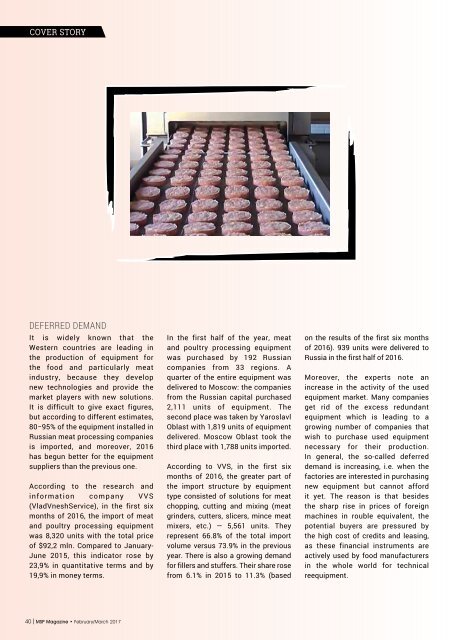MSP Issue 24
You also want an ePaper? Increase the reach of your titles
YUMPU automatically turns print PDFs into web optimized ePapers that Google loves.
cover story<br />
Deferred Demand<br />
It is widely known that the<br />
Western countries are leading in<br />
the production of equipment for<br />
the food and particularly meat<br />
industry, because they develop<br />
new technologies and provide the<br />
market players with new solutions.<br />
It is difficult to give exact figures,<br />
but according to different estimates,<br />
80−95% of the equipment installed in<br />
Russian meat processing companies<br />
is imported, and moreover, 2016<br />
has begun better for the equipment<br />
suppliers than the previous one.<br />
According to the research and<br />
information company VVS<br />
(VladVneshService), in the first six<br />
months of 2016, the import of meat<br />
and poultry processing equipment<br />
was 8,320 units with the total price<br />
of $92,2 mln. Compared to January-<br />
June 2015, this indicator rose by<br />
23,9% in quantitative terms and by<br />
19,9% in money terms.<br />
In the first half of the year, meat<br />
and poultry processing equipment<br />
was purchased by 192 Russian<br />
companies from 33 regions. A<br />
quarter of the entire equipment was<br />
delivered to Moscow: the companies<br />
from the Russian capital purchased<br />
2,111 units of equipment. The<br />
second place was taken by Yaroslavl<br />
Oblast with 1,819 units of equipment<br />
delivered. Moscow Oblast took the<br />
third place with 1,788 units imported.<br />
According to VVS, in the first six<br />
months of 2016, the greater part of<br />
the import structure by equipment<br />
type consisted of solutions for meat<br />
chopping, cutting and mixing (meat<br />
grinders, cutters, slicers, mince meat<br />
mixers, etc.) — 5,561 units. They<br />
represent 66.8% of the total import<br />
volume versus 73.9% in the previous<br />
year. There is also a growing demand<br />
for fillers and stuffers. Their share rose<br />
from 6.1% in 2015 to 11.3% (based<br />
on the results of the first six months<br />
of 2016). 939 units were delivered to<br />
Russia in the first half of 2016.<br />
Moreover, the experts note an<br />
increase in the activity of the used<br />
equipment market. Many companies<br />
get rid of the excess redundant<br />
equipment which is leading to a<br />
growing number of companies that<br />
wish to purchase used equipment<br />
necessary for their production.<br />
In general, the so-called deferred<br />
demand is increasing, i.e. when the<br />
factories are interested in purchasing<br />
new equipment but cannot afford<br />
it yet. The reason is that besides<br />
the sharp rise in prices of foreign<br />
machines in rouble equivalent, the<br />
potential buyers are pressured by<br />
the high cost of credits and leasing,<br />
as these financial instruments are<br />
actively used by food manufacturers<br />
in the whole world for technical<br />
reequipment.<br />
40 | <strong>MSP</strong> Magazine • February/March 2017

















